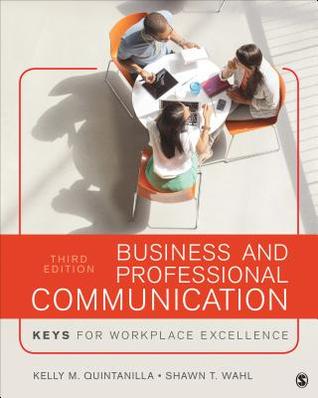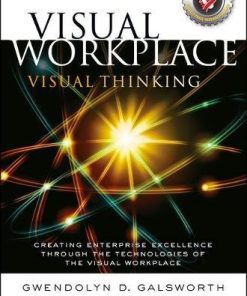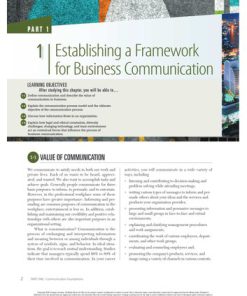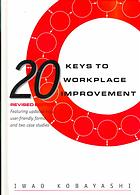Business and Professional Communication Keys for Workplace Excellence 3rd edition by Kelly Quintanilla, Shawn Wahl ISBN 1506341497 9781506341491
$50.00 Original price was: $50.00.$25.00Current price is: $25.00.
Business and Professional Communication Keys for Workplace Excellence 3rd edition by Kelly M Quintanilla, Shawn T. Wahl – Ebook PDF Instant Download/Delivery: 1506341497, 978- 1506341491
Full download Business and Professional Communication Keys for Workplace Excellence 3rd Edition after payment

Product details:
ISBN 10: 1506341497
ISBN 13: 978-1506341491
Author: Kelly M Quintanilla, Shawn T. Wahl
Professional success requires excellent communication skills. Organized around the transition from student to professional life, Business and Professional Communication, Third Edition gives readers the tools they need to move from interview candidate to team member to leader. Kelly M. Quintanilla and Shawn T. Wahl help students understand the role communication plays when successfully handling situations like job interviewing, providing feedback to supervisors, and working in teams. The fully updated Third Edition includes expanded coverage of making competent choices in new communication channels, increased emphasis on skill building for business writing and presentations, and the effective use of visual aids.
Business and Professional Communication Keys for Workplace Excellence 3rd Table of contents:
Part I: Beginning Communication Principles
-
Chapter 1: Business and Professional Excellence in the Workplace
- What Is Business and Professional Communication? – Defining communication in professional settings.
- Business and Professional Excellence in Context – Importance of effective communication for success in business.
- Understanding the KEYS Process – Framework for achieving excellence in communication.
- Communication: A Complex Process – Recognizing the complexity of communication, especially in business.
- Social Media and Technology – Challenges posed by digital communication.
- Communication Apprehension – Overcoming anxiety in professional communication.
- Communication Ethics – Ethical considerations in business communication.
- KEYS for Excellence in the Workplace – Guidelines to ensure high standards of communication.
-
Chapter 2: Verbal and Nonverbal Communication
- Verbal Communication – Role of language, tone, and clarity in professional communication.
- Nonverbal Communication – How body language, facial expressions, and gestures convey messages.
- Codes of Nonverbal Communication – Understanding cultural and contextual differences in nonverbal signals.
- Forming Relationships With Verbal and Nonverbal Communication – How both verbal and nonverbal cues shape workplace relationships.
- KEYS to Excellence in Verbal and Nonverbal Communication – Best practices for effective verbal and nonverbal communication.
-
Chapter 3: Listening
- Hearing and Listening – Difference between hearing (physical) and listening (active process).
- Barriers to Listening – Identifying and overcoming obstacles to effective listening.
- Listening Styles and Categories – Understanding different listening preferences and styles.
- Improving Your Listening – Techniques for becoming a better listener.
- KEYS to Listening Excellence – Strategies for achieving listening excellence in the workplace.
Part II: Entering the Workplace
-
Chapter 4: Résumés, Interviews, and Negotiation
- The Job-Seeking Process – Stages involved in the job search.
- Stage One: Exploring – Self-assessment and identifying career goals.
- Stage Two: Researching – Gathering information about job opportunities and companies.
- Stage Three: Applying – Writing and submitting effective resumes and cover letters.
- Stage Four: Interviewing – Mastering interview techniques and strategies.
- Stage Five: Following Up – Importance of follow-up communications after an interview.
- Stage Six: Negotiating – Negotiating salaries, benefits, and terms of employment.
- KEYS to Excellence in the Job-Seeking Process – Tips for job-seeking success.
-
Chapter 5: Getting to Know Your Diverse Workplace
- Learning Your Workplace Culture – Adapting to your company’s culture and values.
- Assimilating College Students – Transitioning from college to a professional environment.
- Diversity in Your Workplace – Understanding and embracing diversity.
- Examples of Diversity in Professional Contexts – Real-world examples of workplace diversity.
- KEYS to Excellence in Getting to Know the Diverse Workplace – Best practices for integrating into a diverse workplace.
Part III: Developing in the Workplace
-
Chapter 6: Interpersonal Communication at Work
- Exploring Relationship Types at Work – Different professional relationships (e.g., manager-subordinate, peer-to-peer).
- The Line Between Professional and Personal – Balancing professional boundaries with personal interactions.
- Professional Etiquette – Norms and expectations for behavior in the workplace.
- KEYS to Excellence in Interpersonal Communication – Tips for building strong, professional relationships.
-
Chapter 7: Strengthening Teams and Conducting Meetings
- How Do Groups Differ From Teams? – Distinguishing between groups and teams in a work environment.
- Conducting Meetings – Best practices for leading and participating in meetings.
- Shared Leadership – Understanding leadership dynamics in teams.
- Problem Solving – Collaborative approaches to solving workplace challenges.
- Cultivating Innovative Thinking – Fostering creativity within teams.
- Conflict in Team Meetings – Managing conflict and finding solutions.
- KEYS to Excellence in Team Communication – Guidelines for effective teamwork and communication.
Part IV: Excelling in the Workplace
-
Chapter 8: Technology in the Workplace
- Communication and Technology – Role of digital tools and platforms in modern business communication.
- Drawbacks of Technology – Challenges such as information overload, miscommunication, and lack of personal touch.
- Professional Etiquette With Technology – Maintaining professionalism while using email, social media, etc.
- KEYS to Excellence With Communication and Technology – Tips for effectively using technology while maintaining professionalism.
-
Chapter 9: Business and Professional Writing
- The Importance of Written Communication – Why written communication is essential in business.
- Types of Written Communication – Emails, reports, memos, and other professional documents.
- KEYS to Excellence in Written Communication – Writing with clarity, purpose, and professionalism.
-
Chapter 10: Leadership and Conflict Management
- What Is Leadership? – Defining leadership in a business context.
- Utilizing Power – Understanding and ethically using power as a leader.
- Improving Communication With Leadership Theories – Applying leadership theories to enhance communication.
- Hiring the Right Team – Effective recruitment and team building.
- Following Up and Following Through – Importance of follow-up in leadership.
- Communicating About Your Team – Reporting and advocating for your team effectively.
- Dealing With Difficult People – Handling conflict and challenging personalities.
- Giving Feedback – Best practices for providing constructive feedback.
- KEYS to Excellence in Leadership – Traits and skills that define an effective leader.
Part V: Presenting in the Workplace
-
Chapter 11: Informing and Persuading
- The Importance of Presenting With Professional Excellence – Why presentation skills matter.
- Identifying Presentation Opportunities and Purposes – Understanding the purpose of your presentation.
- Speaking to Inform – Techniques for delivering informative presentations.
- Speaking to Persuade – Strategies for persuasive speaking.
- KEYS to Excellence in Professional Presentations – Best practices for effective presentations.
-
Chapter 12: Speech Design
- Analyzing the Audience – Understanding the audience’s needs and expectations.
- Analyzing the Context – Considering the setting and circumstances of your presentation.
- Researching – How to gather and organize relevant information.
- Organizing Your Presentation – Structuring a clear and compelling speech.
- Introductions and Conclusions – Crafting powerful openings and closings.
- Language – Choosing language that resonates with your audience.
- KEYS to Excellence in Speech Design – Tips for designing a memorable and impactful speech.
-
Chapter 13: Delivering a Speech With Professional Excellence
- Delivering a Presentation With Professional Excellence – Techniques for speaking confidently and effectively.
- PowerPoint and Other Supporting Aids – Using technology to enhance your presentation.
- Practice Makes Perfect – The importance of rehearsal.
- Team Presentations – Strategies for presenting as a team.
- KEYS to Excellence in Delivering a Speech – Final tips for polished delivery.
Part VI: Surviving in the Workplace
- Chapter 14: Work–Life Balance
- The Importance of Work–Life Balance – Understanding how balance contributes to personal and professional success.
- Triggers to Imbalance – Recognizing factors that lead to imbalance.
- Strategies for Balance – Approaches to manage both personal and professional demands.
People also search for Business and Professional Communication Keys for Workplace Excellence 3rd :
english for business and professional communication
business and professional communication quarterly
introduction to business and professional communication
spch 1321 business and professional communication
effective business communication asha kaul
Tags:
Kelly Quintanilla,Shawn Wahl,Business,Professional,Communication,Keys,Workplace,Excellence 3rd
You may also like…
Business & Economics - Management & Leadership
Technique - Communication
BCOM 10: Business Communication 10th Edition Carol M. Lehman
Business & Economics - Others
Business and Professional Communication 3rd Edition Steven A. Beebe
Uncategorized
Children's Books - Literature & Fiction
Business & Economics - Others
Applying Communication Theory for Professional Life: A Practical Introduction Marianne Dainton
Biology and other natural sciences - Plants: Botany
Relationships & Lifestyle - The Art of Communication












